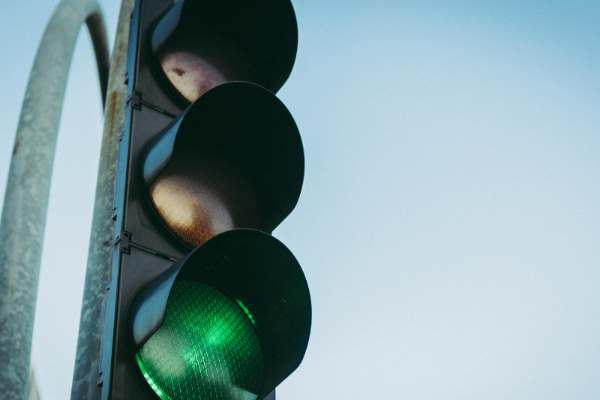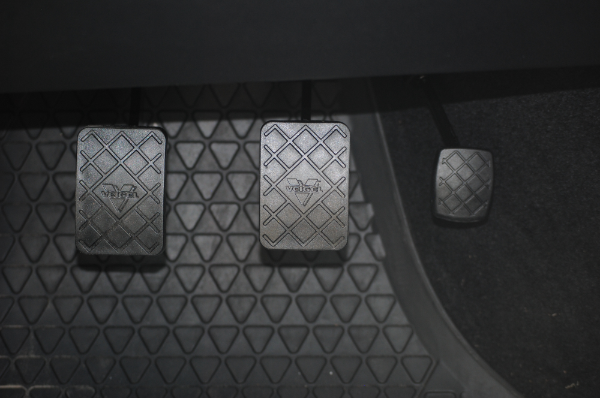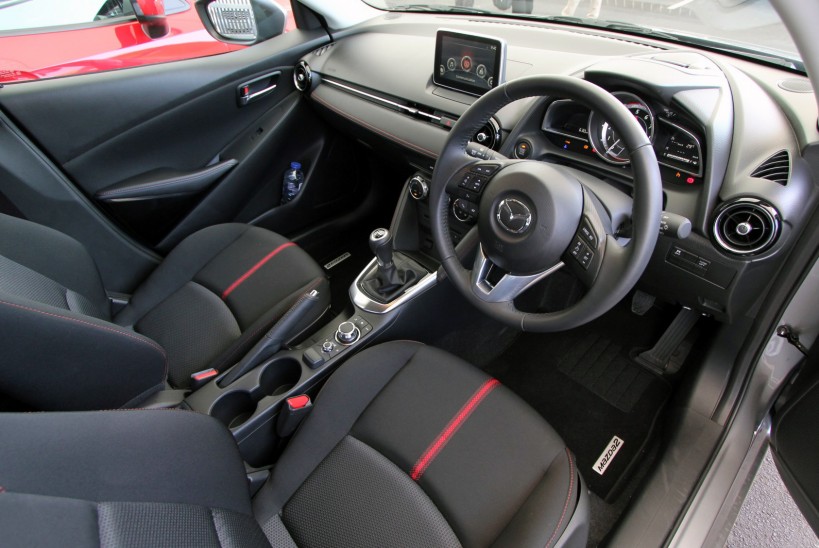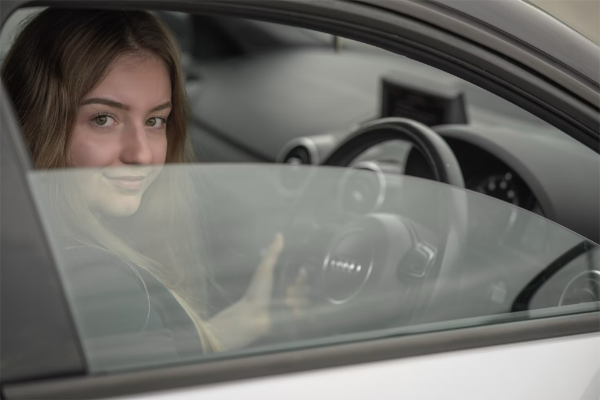Lessons Cockpit Checks & Controls
Introduction
The main aim of the first lesson is to teach you about the car and the main controls of the vehicle, as well as the checks that should be made before driving.
The Cockpit Drill
The cockpit drill is a simple sequence of actions that must be carried out each time that you sit behind the driving wheel.
The best way to remember it is D-S-S-S-M.
- DOORS:
Make sure that all the doors are firmly shut. Most modern cars have audible and visual alarms to warn you when the doors or boot are open. Another visual check is to look at the flushness of the doors in the wing (side) mirrors.
- SEAT:
-
Adjust the base of your seat so that you can operate the foot pedals easily. Ensure that you can fully depress the clutch pedal while not over stretching your left leg. You should retain a slight bend in your left knee to help with clutch control. Many people make the mistake of thinking that the closer you are to the pedals the better the control; this is not always the case. If you are too close you may find that you get jerky gear changes, or clutch slip.
Adjust the backrest of your seat so that you can reach all of the steering wheel with your arms slightly bent. A good tip is to fully extend your arms over the top of the steering wheel. You should be able to rest your wrists on the wheel allowing your hands to dangle over. When adjusting the back of your seat, make sure that the 'head restraint' is adjusted correctly to protect your neck. The main body of the restraint should be behind your eyes and ears and as close to your head as possible.
- SEATBELTS:
Fasten your seatbelt and make sure that your passengers fasten theirs, You, the driver, are legally responsible for seatbelt wearing by children under 14 years of age. You should ensure that there are no twists and take up any slack.
- STEERING:
Many of today's cars allow you to adjust the steering wheel to a height that suits you. If this is possible then adjust it at this point.
- MIRRORS:
Adjust all of your mirrors so that you can obtain a clear view of the road behind and to the side of your vehicle. Use your left hand to adjust the interior mirror and be careful not to touch the surface of the mirrors with your fingers. You should frame the back window in the mirror to see as much as possible behind.
Remember that the exterior mirrors are convex (i.e. curved to give a wider field of vision) and that anything you can see may be closer than you think.
Do not attempt to adjust the seating, steering or mirrors whilst the car is moving.

Lessons The Main Controls
The first controls that you need to learn about are the 'main' foot and hand controls.
Controls Foot Pedals
- The Accelerator Pedal
The accelerator or gas pedal is used with the right foot to control the speed of the car by increasing or decreasing the flow of fuel to the engine. This occurs when the car is in gear and the clutch plates are together. The pedal requires very little pressure to operate and should be used very lightly.
- The Foot Brake
The foot brake operates brakes on all four wheels and is used to slow the car down. When you press this pedal the brake lights on the back of the car come on to warn other drivers that you are slowing down or stopping. The pedal should be squeezed gently at first then pressed progressively harder until you reach the required speed.

- The Clutch
The clutch is used with the left foot to break the connection between the engine and the transmission to the wheels by separating the clutch plates. You will use it when changing gear, moving off and stopping, and to manoeuvre the vehicle at very slow speeds. To operate the pedal you press it firmly as far as it will go and then release it slowly and smoothly.
The video shows how the drive from the engine, on the left, passes through the clutch to the gearbox, on the right.
When the clutch pedal is pressed springs and levers pull the gearbox-side clutch plate away from the engine-side clutch plate, creating a gap and disconnecting the drive.
You can see how, when the clutch is activated, the gearbox has nothing driving it. This allows you to change gear, up or down, relative to the speed that your car is now travelling at. As the clutch pedal is released the plates come back together and the drive is resumed.
You can press the clutch pedal down as quickly as you like but, when releasing it, you should bring it up slowly and smoothly. Bring it up too quickly and you risk jerky and uncomfortable gear changes. Bringing it up too quickly may also reduce the lifespan of your clutch and you don't want to incur unnecessary costly repairs.
Controls Hand Controls
- The Handbrake
The handbrake is used to hold the car still after it has stopped. Because the handbrake is only connected to two wheels by use of a cable it should not be used when the car is moving.
To apply the handbrake you press the button with your thumb and pull the lever upwards as far as it will go and then release the button. To release the handbrake you lift the handbrake slightly, press the button and push the lever down.
- The Gear Stick
The gear lever is used (with the clutch) to select the gears. On most modern cars there are usually five forward gears and one reverse gear. Between the gears there is a central position called neutral. When the lever is in this position, no gear is selected.
First gear provides the power to move the vehicle from a standing start and, as you build up speed and momentum, you will gradually work your way through to the higher gears, which allow more speed but have less power.
- The steering wheel
The steering wheel is used to turn the front wheels when changing direction. If you think of the wheel like a clock face you should normally hold the wheel with your hands in the "ten to two" or "quarter to three" positions. Most control is gained when the "push / pull" method is used to turn the wheel.
- The Indicators
The indicator switch is usually located on a 'stalk' to the left or right of the steering wheel. The switch is designed for fingertip control. To signal that you wish to turn left or right you simply move the switch in the same direction as the steering wheel turns for the manoeuvre.

Co-ordination Putting It All Together
Introduction
As you drive about you will quickly realise that the journey is punctuated by stops and starts as you negotiate the various hazards.
Co-ordination Moving Off
Moving off is easy so long as you follow a basic routine. Once you have started the engine and prepared the car for moving you use the Mirrors- Signal-Manoeuvre routine to move away. Do not rush this routine as you will get quicker naturally through practice.
- Starting The Engine
Before starting the engine you should check that the handbrake is on and that the gear lever is in neutral. Turn the ignition key and immediately release it as the engine starts, this avoids damaging the starter motor. Many cars nowadays use start buttons.
- Get The Car Ready To Move (Prepare)
Press the clutch down as far as it will go. Select first gear using the "palming" technique.
"Set the gas" by pressing the gas pedal slightly until you hear a noticeable but gentle hum, then hold it still. Press it to generate sufficient power to move.
Bring the clutch up until the sound of the engine drops slightly, you may also feel the vibration change and the car "dip" slightly. This is called the clutch 'biting point'- the point at which both clutch plates are starting to bite together and therefore the point at which the car wants to move.
Keep both feet still.
- Mirrors, Signal (Observe)
Check your mirrors, working in a logical order from left (nearside) door mirror, then the interior mirror, then the right (offside) door mirror. Is it safe to proceed? Look over your right shoulder to check your offside blind-spot. Is it still safe to proceed?
Signal, if anyone will benefit and return your hand to the handbrake.
- Manoeuvre (Move)
When you are sure that it is safe to move, release the handbrake. Press the gas pedal a little more, if necessary. Bring the clutch up slightly (the thickness of a pound coin). When the car moves hold the clutch still, allowing it to roll and gain some momentum.
As the car begins to gain some momentum bring the clutch up (very gently) all the way and rest your foot by the side of the pedal on the floor. Make a check of your mirrors as you start to move. Steer to your normal driving position, about a metre from the kerb (at least a drains width), switching off the signal, if used.
Press the gas pedal to pick up speed and look well ahead.
Co-ordination Stopping
Apply the Mirrors-Signal-Manoeuvre routine for stopping.
Decide where you are going to stop and check your mirrors to ensure it is safe. Signal if it will benefit anyone. Steer closer, but parallel to the kerb. Check your nearside mirror to ensure a suitable gap from the kerb. Press the foot brake progressively harder and just before the car stops begin to ease off and then depress the clutch pedal fully down as you stop. Finally, make the car safe; apply the handbrake, select neutral, remove your feet from the pedals and cancel the signal, if used.

